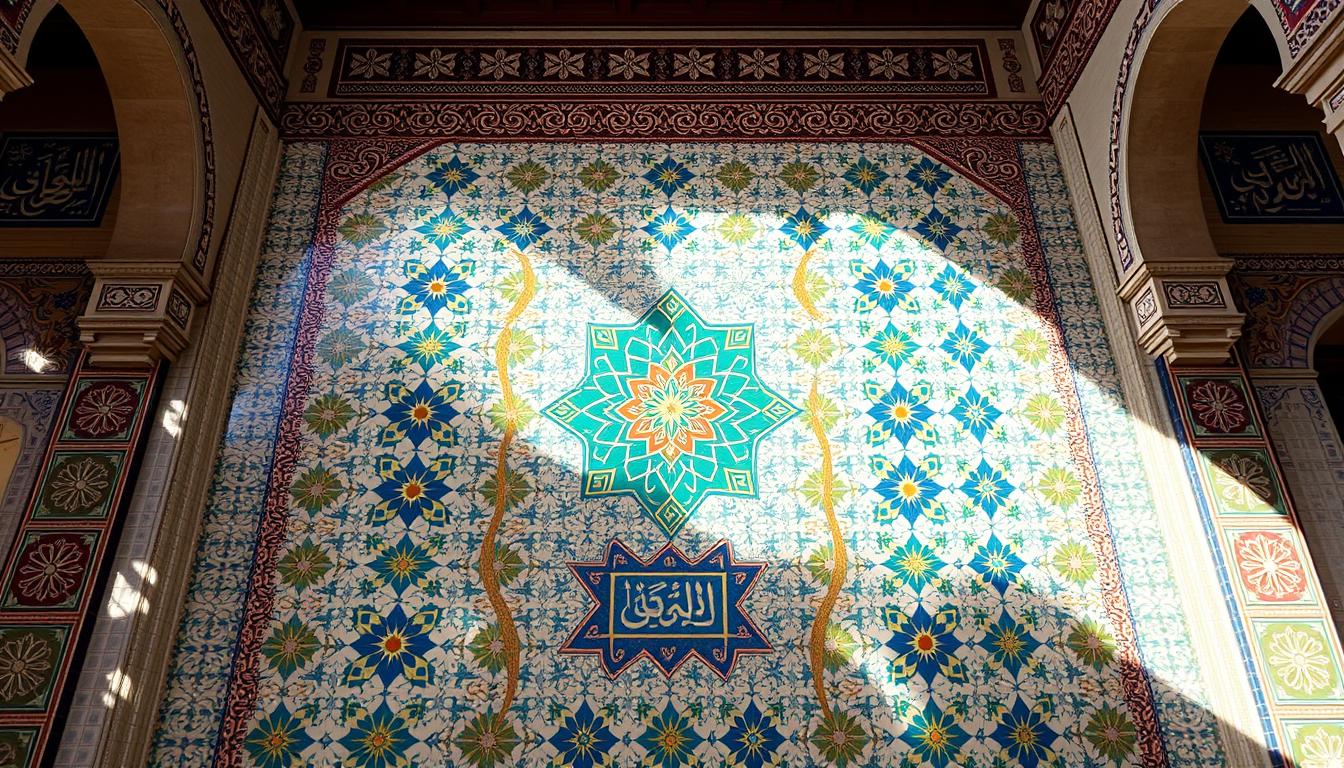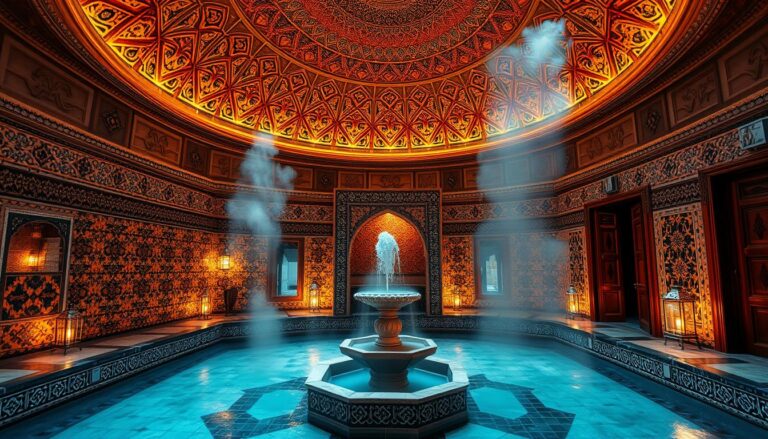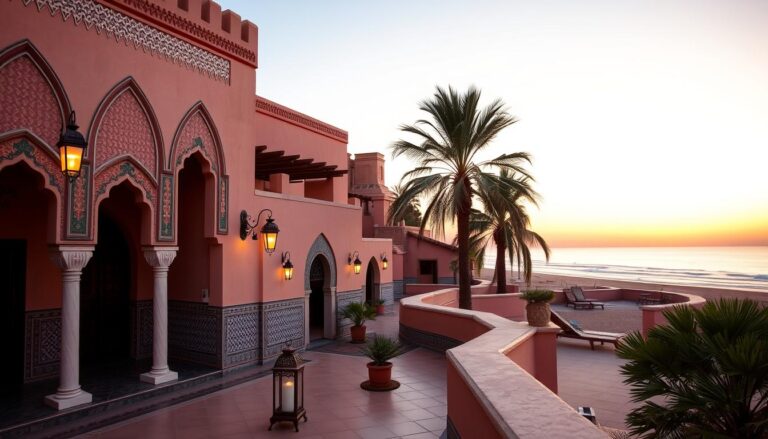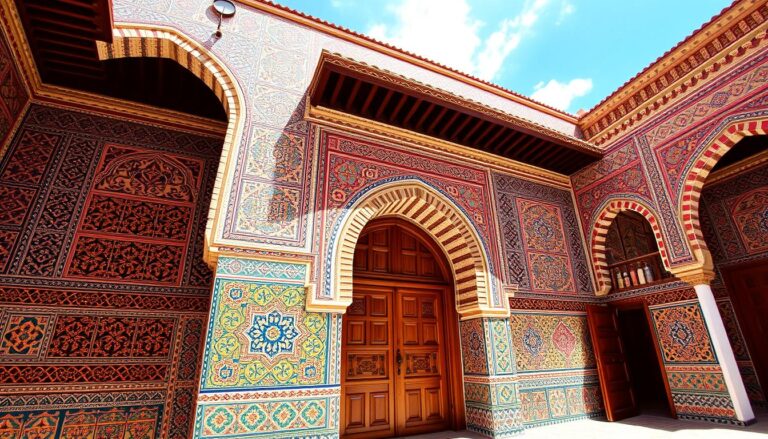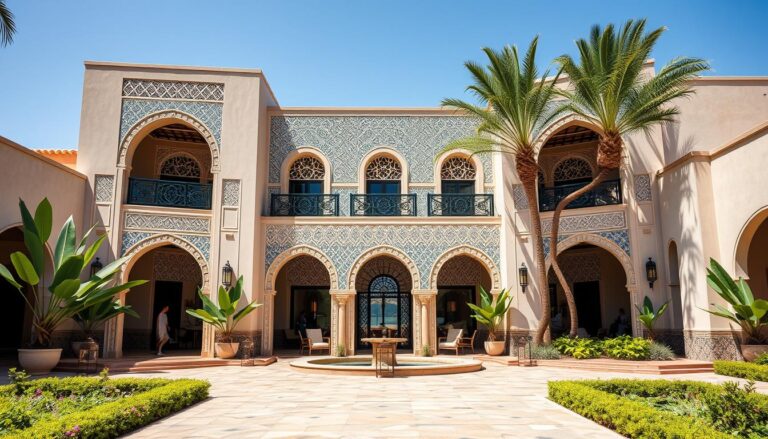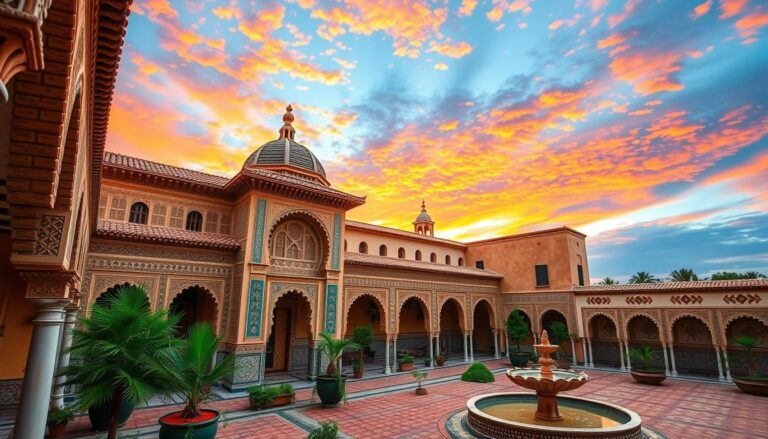In Morocco, architecture is a mix of beauty and faith. The country’s buildings, from tall minarets to detailed patterns, show the power of belief. These designs tell stories of faith and culture, making Morocco’s architecture truly special.
But what do these buildings really mean? How have they shaped Morocco’s identity? Let’s explore the deep religious roots in Moroccan design.
Key Takeaways
- Moroccan architecture is deeply rooted in religious influences, reflecting the country’s Islamic heritage.
- Architectural elements like minarets, domes, and intricate geometric patterns are imbued with spiritual symbolism.
- Religious buildings, such as mosques and medersas, showcase the unique fusion of function and aesthetic in Moroccan design.
- The arrival of Islam in the 8th century significantly shaped the built environment, introducing new societal norms and design principles.
- Moroccan architecture seamlessly blends local Amazigh traditions with the artistic currents of the broader Islamic world.
Introduction to Moroccan Architecture
Morocco’s architecture is a mix of many influences, showing the country’s rich culture. It sits at the meeting point of Africa, the Middle East, and Europe. This has made Morocco a place where many cultures blend, each adding its own touch to buildings.
Moroccan Architecture’s Unique Blend of Influences
Moroccan architecture combines Islamic architecture, Berber architecture, Moorish architecture, and French colonial architecture. You can see Islamic designs in the detailed patterns and Islamic calligraphy. The use of zellij (ceramic-tile mosaic) is also common.
The Hispano-Moorish style, from the Almoravid dynasty, is seen in grand palaces and medinas. It’s known for its fancy details, arched doors, and beautiful courtyards.
Design Elements in Moroccan Architecture
Moroccan architecture is known for its unique design elements. The geometric patterns and calligraphic inscriptions are both beautiful and full of meaning. They make Moroccan buildings stand out.
“Moroccan architecture is often described as a country of allure, mystery, and beauty, and this is in part due to its unique blend of design elements.”
The open courtyards with lush gardens and the use of natural light add to the beauty of Moroccan buildings. They show the country’s love for nature.
The architectural wonders of Morocco, like the Fez medina, the Hassan II Mosque in Casablanca, and the Alhambra in Spain, show the country’s rich cultural history. They highlight the lasting impact of Moroccan architecture.
The Influence of Islam
The arrival of Islam in Morocco changed the country’s architecture and design. Idris I, a descendant of the Prophet Mohammed, started the Idrisid dynasty in the 8th century. He encouraged Berber clans to convert to Islam. This led to a new era in architecture, with mosques becoming a key feature.
Islamic Design Elements in Moroccan Architecture
Islamic design elements became common in Moroccan buildings. You can see zellij (Moroccan tiles), geometric patterns, and floral arabesques everywhere. Fountains, seen as a symbol of paradise, were also added to buildings.
Mosques in Morocco show the strong Islamic influence. Each mosque has its own style. They feature the mihrab and minbar, important for Islamic rituals.
“The architecture created by the Mamluks in Syria and Egypt has lasted into the 21st century, with nearly 3,000 major monuments preserved or known from texts.”
Islam’s influence went beyond mosques. Zellij tiles, geometric patterns, and floral motifs are found throughout Morocco. They show Islamic design elements in Moroccan architecture and decor.
The Berber Kingdom’s Influence
The history of Moroccan architecture goes back to the Berber Kingdom of Mauretania, starting in 110 BCE. The Berber clan, also known as the Amazigh, were the original people of North Africa. Their architectural legacy has deeply influenced Moroccan design.
The Berbers were known for building with mud brick, or pise. Their structures, like trade posts and defensive buildings, were made for safety and protection. They used consistent materials and patterns, a style still seen in Moroccan architecture today.
“An estimated 20 million Berbers are living in Morocco today, making them the oldest indigenous tribe in North Africa.”
The Berber people’s impact went beyond just buildings. Their culture, rituals, and beliefs merged with Moroccan architecture. This blend has lasted for centuries, shaping Morocco’s unique buildings.
The Berber Kingdom’s architecture shows their creativity and strength. It’s a reminder of their lasting impact on North Africa. Their influence is still celebrated in Moroccan design, keeping their cultural heritage alive.
Religious influences on design in Morocco
The influence of Islam on Moroccan architecture is clear in religious buildings like mosques and mederasas. These structures show how deep religious influences have shaped Morocco’s buildings.
Islamic Architectural Elements in Religious Buildings
Mosques are key religious sites in Morocco. Their walls and fountains are covered in green and white zellij tiles. They also have a mirhab in stucco and marble that points to Mecca.
The inside of these buildings is filled with elaborate geometric patterns and ornamental Islamic calligraphy of Quranic verses. The green and white zellij shines brightly, adding to the beauty.
Religious Symbolism and Motifs in Moroccan Design
Islam’s ban on images has made patterns and motifs central in Moroccan religious design. You’ll find geometric motifs, Quranic verses, and religious symbolism in mosques and mederasas. These elements also appear in residential homes and public buildings.
“The materials predominantly used in Moroccan designs are stone, ceramic, plaster, and wood.”
The zellig (traditional Moroccan tilework) has evolved, showing a wider color range in late 19th and early 20th-century buildings. This has added more to the religious symbolism and geometric motifs that define Moroccan design.
The Moorish (Spanish) Influence
The Berber Kingdom ruled over Morocco and southern Spain, leaving a big mark on architecture. They introduced horseshoe arches and cusped arches to the Moroccan style. They also made overlying roofing tiles and hand-glazed tiles more common.
The Alhambra Garden was a highlight of the Moorish era. It inspired the Andalusian gardens found throughout Morocco. The era’s buildings were known for their sharp white walls.
The Moorish influence in Morocco comes from the Almoravid dynasty, Almohad Caliphate, and Marinid dynasty. These Berber kingdoms ruled both Morocco and parts of Spain. This led to a unique Hispano-Moorish style that mixed Moorish and Spanish designs.
“The Moors, as the Europeans called the invaders, left a legacy in Spanish architecture, music, food, and language in the region known as al-Andalus.”
The French Colonial Influence
The French colonial presence in Morocco left a lasting impact on its architecture. In 1912, the French took over Morocco and were worried about the rapid growth of buildings. They introduced building rules to shape Moroccan architecture’s future.
French Building Regulations and Their Impact
The French made a rule that buildings should not be more than four stories high. They also said roofs had to be flat, so people couldn’t look over their neighbors. Buildings were also limited to 80% of the land, with 20% for gardens or courtyards.
These building regulations greatly influenced Moroccan architecture under the French colonial influence. The rules on height and the focus on outdoor space and balconies made buildings more beautiful and in line with the country’s landscape and culture.
“The French colonial administration’s strict building regulations helped to shape the unique character of Moroccan architecture, preserving its traditional essence while adapting to modern needs.”
Today, you can still see the French colonial influence in Morocco’s architecture. Many buildings have level roofs, balconies, and well-designed outdoor spaces. These features, along with Morocco’s rich culture, have created a unique architectural style. It is both beautiful and deeply connected to Morocco’s history.
Experiencing Moroccan Architecture Today
When you visit Morocco, you’ll see its amazing architecture. You’ll notice the detailed patterns and beautiful archways. The Moroccan tiles and green courtyards add to the beauty. Places like Casablanca, Fes, and Marrakesh are great for seeing this mix of old and new.
Popular Destinations for Moroccan Architecture
In Casablanca, the old town is full of traditional buildings. But the city also has modern skyscrapers and busy areas. Fes is famous for its medieval medina, a UNESCO site with many riads, kasbahs, mosques, and mederasas. Marrakesh, known as the “Red City,” has landmarks like the Koutoubia Mosque and Bahia Palace.
Traditional and Modern Moroccan Buildings
In Morocco, old and new architecture come together beautifully. Traditional buildings like riads and mosques show off intricate designs and Zellij tiles. At the same time, modern buildings respect the past while introducing new ideas. This mix creates a unique and beautiful look.
“The architecture of Morocco blends influences from Arab, Berber, and European cultures, as well as earth and Islamic architecture, creating a truly unique and captivating aesthetic.”
Conclusion
Moroccan architecture shows the country’s varied geography and long history. It has been shaped by many settlers and conquerors. This heritage includes ancient Roman sites, historic Islamic buildings, local styles, French colonial designs, and modern structures.
The biggest influence on Moroccan architecture is Islam. It has guided building designs and decorations for centuries. This influence is still strong today.
Berber, Moorish, and French styles also play a big role in Moroccan architecture. They mix together to create a unique look that is Morocco’s own. Today, old and new buildings live together, showing off Morocco’s rich culture and design.
As Morocco faces modern challenges, its buildings tell its story. From the detailed tilework in mosques to the modern buildings in cities, Moroccan architecture is powerful. It shows how design can reflect and shape a nation’s story.
Source Links
- Moroccan Architecture: In-Depth Review of Styles in Morocco
- The Rich and Vibrant History of Moroccan Architecture.
- Moroccan architecture
- A Dialogue in Art and Architecture: Morocco and Spain | IES Abroad
- A Journey Through Time and Culture – Archi kouidich
- Islamic arts – Moorish, Architecture, Decoration | Britannica
- Islamic Architecture in Morocco, Your Morocco Travel Guide |
- Uncovering the Mystique of Morocco – Google Arts & Culture
- Who Are the Berbers of Morocco? Unveiling North Africa’s Indigenous Secrets
- STUDY TRIPS ABROAD – Exploring Moroccan Design
- The Fascinating History of Moorish Design
- Moorish architecture
- The Enduring Echoes of Moorish Spain (Published 2022)
- 13 Interesting Moorish Influences in Spain
- French Colonial Art Education in Morocco
- Studio BO surfs through traditional Moroccan architecture for Tayourt
- Travel Morocco – Moroccan Heritage & People
- “They have no taste in Morocco.” Home furnishing, belonging, and notions of religious (im)perfection among white Dutch and Flemish converts in Morocco – Contemporary Islam
- Moroccan Fashion: Design, Tradition and Modernity
- Morocco Culture : Language, Religion, Food

The Editorial Team is a passionate group of Morocco enthusiasts dedicated to sharing the beauty, culture, and wonders of this captivating country. With diverse backgrounds and a deep love for travel, we strive to bring you engaging and informative content that inspires your Moroccan adventures. From uncovering hidden gems and sharing local insights to exploring mouthwatering cuisine and showcasing the vibrant lifestyle, our team is committed to providing you with valuable resources and exciting stories that enhance your exploration of Morocco. Join us on this journey as we celebrate the rich heritage and unforgettable experiences that make Morocco truly special.

